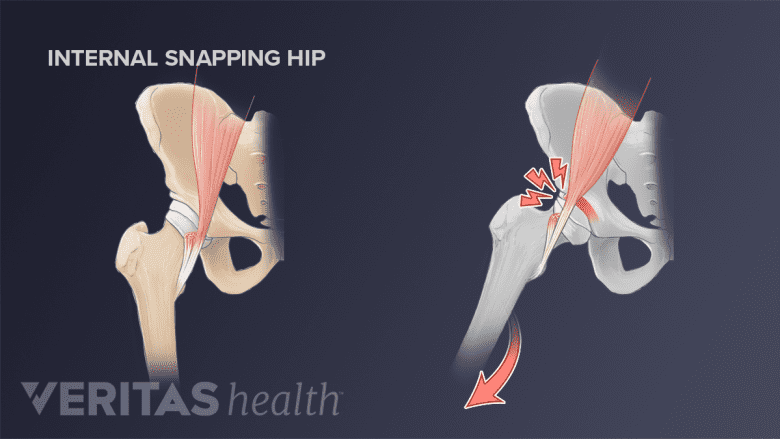Runners’ bodies undergo a lot of repetitive pounding that can lead to hip or thigh pain. More than one condition can develop at the same time, so diagnosing the cause of hip or thigh pain can be challenging.
A patient can help his or her doctor make an accurate diagnosis by noting the pattern of symptoms, including the exact location of pain, when it occurs, and what—if anything—makes it go away.
Common hip and thigh conditions in runners include:
In This Article:
- Common Running Injuries: Knee Pain
- Common Running Injuries: Foot and Ankle Pain
- Common Running Injuries: Calf and Shin Pain
- Common Running Injuries: Hip or Thigh Pain
- Common Running Injuries: Back Pain
Hip Bursitis (Greater Trochanteric Bursitis)

Greater trochanteric bursitis causes pain and tenderness along the outside of the hip.
Many runners develop pain at the outside of the hip. This pain has several possible causes, including but not limited to hip bursitis. This condition develops when a hip bursa becomes irritated and inflamed.
- A bursa is a small, slippery sac that serves as a cushion and lubricant between bones and other tissues.
- In the hip, the trochanteric bursa is located at the bony knob that sticks out from the top of the femur, called the greater trochanter.
Because outer hip pain has more than one root cause—and because causes are not easy to determine—many doctors prefer the term greater trochanteric pain syndrome.1Olafsen N, Simpson S. Chapter 17 - Hip, Pelvis, and Thigh Injuries in Runners. In: Harrast MA, ed. Clinical Care of the Runner. Elsevier; 2020:181-195. doi:10.1016/B978-0-323-67949-7.00017-3
What it is: With each running stride, soft tissue rubs against the greater trochanter, and the bursa sandwiched between them experiences friction. Too much friction will irritate the bursa and cause it to become inflamed. This inflammation is called hip bursitis or greater trochanteric bursitis.
Inflammation causes the bursa’s membrane to thicken and fill with fluid, leading to hip pain and other symptoms.
How it feels: Greater trochanteric bursitis causes pain and tenderness at the outside of the hip. Lying on the affected is often uncomfortable, making sleep difficult. As the condition gets worse, pain radiates down the outside of the thigh. Pain occasionally radiates to the buttock, groin, and low back.
Read more about Hip (Trochanteric) Bursitis on Arthritis-health.com
Snapping Hip Syndrome

Hip snapping occurs when a taut tendon or muscle slides over a bone in the hip joint.
As the name suggests, this condition causes a pop, click, or snap in the hip joint during certain movements. Snapping hip syndrome is most likely to occur in runners who ramp up their training schedule too quickly, hurdlers, or sprinters who take long strides.
What it is: Hip snapping is usually caused when a taut tendon or muscle slides over a bone in the hip joint.
How it feels: Hip snapping syndrome does not always cause symptoms beyond a snapping sensation and sound. Pain will be triggered if the snapping causes friction and inflammation in a tendon or nearby bursa.
Exactly where pain and other symptoms occur depends on the underlying cause. For example, if the iliotibial band snaps over the outer hip, the snapping may be visible and irritate the trochanteric bursa.
Read more about Snapping Hip Syndrome on Arthritis-health.com
Strained, Torn, or Pulled Muscle

Runners are prone to muscle tears in the hip and thigh, particularly the hamstrings and quadriceps.
Running long distances, sprint training, or sudden starts and stops can cause a muscle injury at the hip or thigh. The risk of tearing a muscle is higher without adequate muscle conditioning and warm-up exercise.
The muscles in the hip and thigh that runners are most likely to tear include:
- Hip flexors at the front of the hip and upper thigh
- Gluteus medius over the outside of the hip and buttock
- Hamstrings at the back of the thigh
- Quadriceps at the front of the thigh
- Adductors, or groin muscles, at the inside of the thigh
What it is: The muscles in the hip and thigh are made of thousands of fibers.2Dave HD, Shook M, Varacallo M. Anatomy, Skeletal Muscle. In: StatPearls. StatPearls Publishing; 2023. Accessed November 14, 2023. http://www.ncbi.nlm.nih.gov/books/NBK537236/ Damage to those fibers is called a tear, strain, or pull.
Doctors sometimes diagnose muscle tears using a grading system:3Hsu D, Chang KV. Gastrocnemius Strain. In: StatPearls. StatPearls Publishing; 2023. Accessed November 12, 2023. http://www.ncbi.nlm.nih.gov/books/NBK534766/
- Grade 1 is considered a strain or mild tear. Less than 10% of the muscle’s fibers are torn.
- Grade 2 is a moderate tear. Between 10% to 50% of the muscle’s fibers are torn.
- Grade 3 is a severe tear. Between 50 to 90% of the muscle’s fibers are torn.
Grade 1 muscle tears usually do not cause symptoms until the next day and heal within a couple of weeks. In contrast, Grade 2 and 3 tears are more severe. Many occur suddenly and require several weeks or months to heal.
How it feels: Muscle injuries cause discomfort, pain, stiffness, and weakness in the area affected. For example, a tear to one or more of the quadriceps muscles will cause symptoms at the front of the thigh.
Grade 1 muscle tears will typically cause mild pain, soreness, and stiffness. Jogging and running will probably be possible but uncomfortable. In contrast, some grade 2 and most grade 3 muscle tears cause sudden, severe pain, bruising, and swelling. Significant tears prevent normal walking, jogging, or running.
Many mild to moderate muscle injuries can be self-diagnosed and treated. Runners with persistent muscle pain that does not resolve in a couple of weeks are advised to seek medical care to rule out other conditions.
For example, a runner with groin pain may have a torn labrum, not a strained adductor muscle. A doctor can provide an accurate diagnosis.
- 1 Olafsen N, Simpson S. Chapter 17 - Hip, Pelvis, and Thigh Injuries in Runners. In: Harrast MA, ed. Clinical Care of the Runner. Elsevier; 2020:181-195. doi:10.1016/B978-0-323-67949-7.00017-3
- 2 Dave HD, Shook M, Varacallo M. Anatomy, Skeletal Muscle. In: StatPearls. StatPearls Publishing; 2023. Accessed November 14, 2023. http://www.ncbi.nlm.nih.gov/books/NBK537236/
- 3 Hsu D, Chang KV. Gastrocnemius Strain. In: StatPearls. StatPearls Publishing; 2023. Accessed November 12, 2023. http://www.ncbi.nlm.nih.gov/books/NBK534766/

